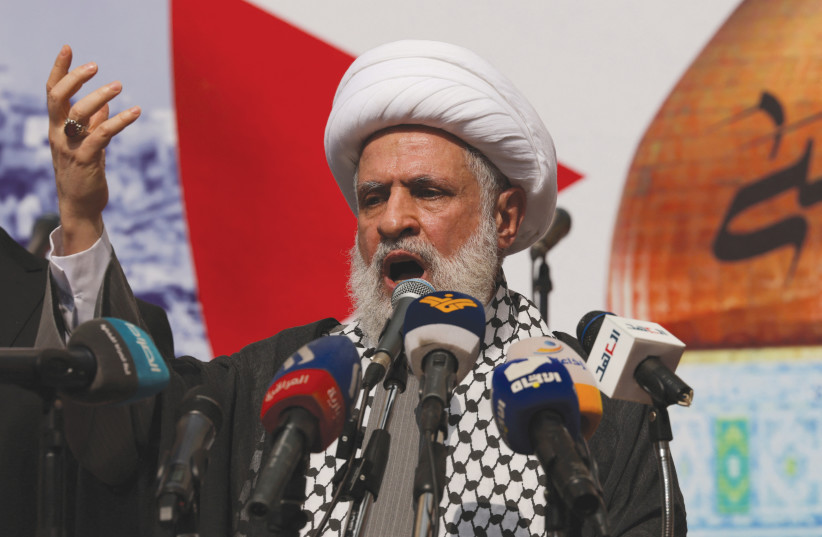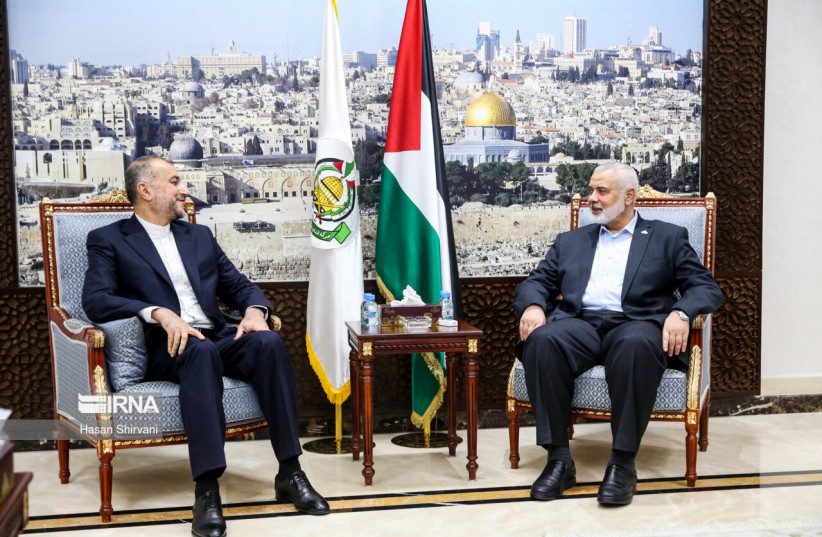Addressing this turbulent situation requires careful consideration of regional dynamics, diplomatic efforts and an understanding of the shared goals and motivations that drive these terrorist groups.
ERFAN FARD OCTOBER 24, 2023 02:23

The IDF has been conducting targeted operations against Hezbollah terrorist targets in Lebanon. It has reported successful strikes on several Hezbollah targets in the southern region of Lebanon. These targets included an observation post situated near the coastline, from which anti-tank missiles were launched in the direction of Rosh Hanikra last Wednesday.
From one side, Iranian Foreign Minister Hossein Amir-Abdollahian warned on Monday evening that Iran’s proxies around the Middle East could launch preemptive strikes on Israel “in the coming hours. Israeli strikes against Hezbollah in Lebanon come hours after Iran’s foreign minister warned about his country “taking ‘preemptive action.”
Iran’s Supreme Leader Ali Khamenei has issued a warning that if Israel’s attacks on Gaza persist, the “Axis of Resistance” will continue to retaliate. This statement signifies his intention to challenge the United States and Israel. Without a doubt, he has direct involvement in the Hamas attack, and has been given the green light from Russia.
The term “resistance forces,” as cited by Ali Khamenei, refers to a transnational network of terrorist criminal groups that the mullah’s regime in Iran supports, including Islamic terrorists like Hamas, Palestinian Islamic Jihad, Hezbollah in Lebanon, Hashd al-Shaabi in Iraq, the Houthis in Yemen, and entities like the Fatemiyoun and Zainbiyoun brigades in Syria. These terrorist groups have received financial and military support from the Iranian regime, and Iran has been perpetuating and extending conflicts in the region.
Remarkably, Hamas and Hezbollah are two Islamic terrorist organizations with different origins, goals, and operations, but they share certain similarities and have some connections primarily based on their shared villainy against Israel and similar destructive ideology.

• Ideological and terrorist ties: Both Hamas and Hezbollah are Islamist terrorist organizations that emerged in the late 1980s and early 1990s with a shared goal of attacking Israel and influence in the Middle East. They are both influenced by Shia Islam and share anti-Israel and anti-Western ideologies.
• The anti-Israel stance: Hamas and Hezbollah are united in their opposition to Israel and have engaged in terrorist conflicts with Israel. They both view Israel as a hostile state and seek its elimination.
• Iranian regime’s support: Both terrorist organizations receive significant support from Iran’s outlaw regime, a Shia theocracy. Iran provides financial, military, and logistical support to both Hamas in Gaza, and Hezbollah in Lebanon. Iran sees them as important as the terrorist Islamic Revolutionary Guard Corps (IRGC) in its struggle against Israel and its regional influence efforts. • Terrorism and operational cooperation: While they operate in different regions (Hamas primarily in the Gaza Strip and Hezbollah in Lebanon), they have exchanged military tactics and strategies. They share experience and expertise in guerrilla warfare, rocket attacks, and terrorist activities against Israeli targets.
• Training and funding: Hezbollah, with its well-established military structure and experience, has reportedly provided training and assistance to Hamas in terms of military tactics and organization. Additionally, both groups receive funding and support from IRGC terrorists and the Quds Force in Iran.
• Political alignment: Hamas and Hezbollah share some common ideological goals, including Islamic terrorism against Israel. They cooperate on certain diplomatic and political fronts, especially within the context of the Palestinian-Israeli conflict and broader regional dynamics. It’s important to note that while they share some commonalities and receive support from similar sources, they remain terrorist organizations with their own specific objectives and operational areas. Hamas primarily focuses on the Palestinian territories, especially the Gaza Strip, while Hezbollah is based in Lebanon.
• Iran’s regional ambitions: Hezbollah and Hamas in a unified front against Israel analysis: Iran’s influence in the Middle East has been a subject of global interest and concern for many years. One aspect of this vicious influence is its support for various terrorist organizations, such as Hezbollah in Lebanon and Hamas in the Gaza Strip, both of which share a common goal of opposing Israel.
The possibility of Iran pushing Hezbollah to join forces with Hamas in a war against Israel was crystal clear. The potential implications of such an alliance on the geopolitical landscape of the region should be considered. Iran has long been a supporter of Hezbollah and Hamas, providing them with financial, military, and ideological support. Hezbollah, based in Lebanon, has a history of terrorist conflict with Israel and is considered a powerful terrorist militia in the region. Hamas, based in the Gaza Strip, has also engaged in numerous terrorist conflicts with Israel and has strong ideological ties with the Iranian mullah’s regime.
• Shared objectives and ideological alignment: Iran supports both Hezbollah and Hamas due to their shared objective of opposing Israel and their ideological alignment as Islamist terrorist militant groups. Their common goal of governing Palestinian territories and their terrorist activities against Israel serve as a basis for potential collaboration.
• Military synergy and strategic alliance: Iran may see potential benefits in encouraging Hezbollah to collaborate with Hamas. Hezbollah possesses significant military capabilities and expertise, and joining forces with Hamas could create a more potent and coordinated front against Israel. Such an alliance could amplify their ability to launch coordinated attacks, engage in terrorist guerrilla warfare, and escalate the conflict strategically.
• Regional geostrategic calculations: Iran’s interest in promoting a united front against Israel is driven by its desire to establish regional dominance and reduce Israel’s influence in the Middle East. Encouraging cooperation between Hezbollah and Hamas allows Iran to further its geopolitical ambitions and strengthen its position as a major player in the region.
Potential implications of the alliance:
An alliance between Hezbollah and Hamas could lead to a significant escalation of the conflict. The increased military capabilities and strategic coordination could result in more intense and prolonged conflicts, causing human suffering and instability in the region.
Such an alliance could potentially shift the balance of power in the Middle East, challenging the existing geopolitical dynamics and alliances. Israel and its allies may need to reassess their strategies and responses to effectively counter this new collaborative front.
The alliance might also pose challenges to diplomatic efforts and the peace process in the Middle East. The united front against Israel could undermine negotiation initiatives and dialogue, making the resolution of the Israeli-Palestinian conflict even more challenging.
In conclusion, while the idea of Hezbollah and Hamas forming a joint alliance against Israel is a possibility, the geopolitical implications of such a collaboration are substantial. Iran’s support for these groups and potential encouragement of this alliance underscores the complex and multifaceted dynamics in the Middle East.
Addressing this turbulent situation requires careful consideration of regional dynamics, diplomatic efforts, and an understanding of the shared goals and motivations that drive these terrorist groups and their supporters.
The Tehran regime plays a significant role in perpetuating and extending warfare, acting as a source of turmoil and Islamic terrorism, so that the terrorist-loving mullahs are the source of mayhem and instability. A bunch of criminal mullahs are ruling the civilized nation.
The writer is a counterterrorism analyst and Middle East studies researcher based in Washington. He is a Jewish Kurd of Iran and the author of The Gruesome Mullah. See more at www.erfanfard.com.
Content retrieved from: https://www.jpost.com/opinion/article-769842.